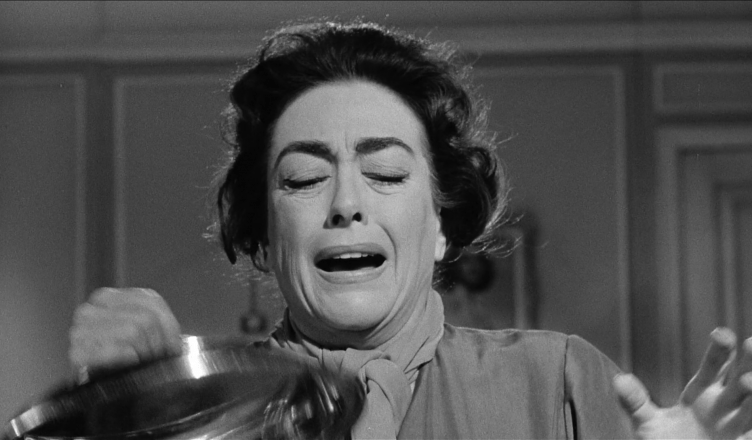Film Deets:
Director: Robert Aldrich
Screenplay: Henry Farrell, Lukas Heller
Actresses: Bette Davis, Joan Crawford
Category: Hagsploitation
Themes: Disability, Caregiving, Mental Illness
Why does this scream matter?
Whatever Happened to Baby Jane? is the story of former child star Jane (Bette Davis) whose tentative grip on reality becomes increasingly obvious as she cares for her paralyzed sister Blanche (Joan Crawford). The film is based on the novel by Henry Farrell and is a potent blend of camp, classic horror, and Grand Guignol.
In this scene, Jane serves Blanche a dead rat on a silver serving tray as Jane then cackles in glee at Blanche’s escalating screams of horror.
It would be easy to dismiss what is happening in this scene as a simple stereotype. The idea that interaction between two women will ultimately devolve into a catfight is so prevalent in our culture, particularly in the 1960s, that it has become a joke that has spanned decades. But it is a joke that is grounded in patriarchal framings of women as overly emotional and inherently jealous. A closer look at this scene reveals that it is fueled by an intriguingly subversive commentary.
While Blanche screams because she is mortified to find she is being served a dead rat by her sister and caregiver, her scream is also one of anguished frustration. Because Blanche is in a wheelchair and is dependent upon Jane for everything, her anger at not being able to be independent and have her own agency is building. The scream here works as a pressure valve of sorts and allows Blanche an opportunity to access and release her rage. Blanche’s scream is a guttural one in which the reality of her situation, particularly her dependence upon her increasingly cruel caregiver, is a scathing critique of the suffering that is endured when there are no systemic safeguards to protect the needs of marginalized populations.
Jane’s scream is especially interesting in this scene for how it works in concert with Blanche’s maniacal laughter. For much of the film, the audience is positioned to see Jane as the villain. But the film’s shocking revelation that Blanche became disabled while trying to kill Jane in a fit of jealousy reframes some of Jane’s motivations. Jane’s mistaken belief that she is to blame for Blanche’s suffering leads to Jane’s mental deterioration, a deterioration that is only exacerbated by the demands of being a constant caregiver. While women today are still statistically most likely to be the caregivers of family relatives, these numbers were even more pronounced in the 1960s when women were still working primarily in the home. Jane’s descent into madness can be read as a statement on the pressures we put on women to be primary caregivers even when doing so is to their detriment. Blanche’s scream and its connection with Jane’s laughter not only demonstrates cyclical abuse but also demonstrates the complexity of emotions that cause women to scream in horror films.
Works Cited
Reinke, Rachel. “Catfight: A Feminist Analysis.” Chrestomathy: Annual Review of Undergraduate Research, School of Humanities and Social Sciences, School of Languages, Cultures, and World Affairs, College of Charleston, Vol. 9, 2010, 162-185, chrestomathy.cofc.edu/documents/vol9/Reinke.pdf.
Whatever Happened to Baby Jane?. Directed by Robert Aldrich, performances by Bette Davis and Joan Crawford, Warner Bros. Pictures, 1962.
“Who Are Family Caregivers?.” American Psychological Association, www.apa.org/pi/about/publications/caregivers/faq/statistics.







